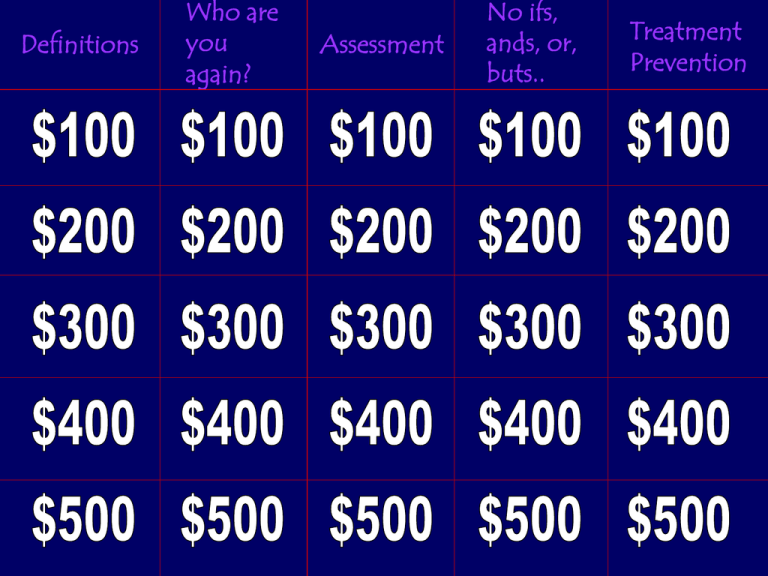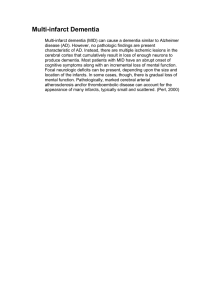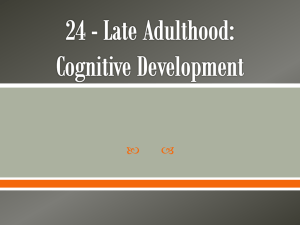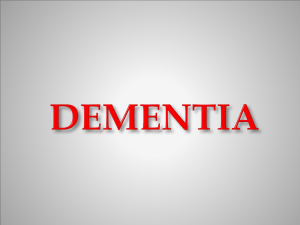Who are No ifs, Treatment you
advertisement

Definitions Who are you again? Assessment No ifs, ands, or, buts.. Treatment Prevention What is the definition of dementia? Acquired cognitive deficits sufficient to interfere with social or occupational functioning in person without depression or clouding of consciousness Alzheimer’s disease Mixed Lewy body Vascular dementia Fronto-temporal CJD 60% 20% 10% 5% 4% <1% What is vascular dementia? patchy loss of neurons in areas of infarcts (multi-infarct, lacunar, periventricular) cognitive changes depend on area of infarct recall improves with cuing, more aware of memory problem Diagnosis: •dementia •vascular component – by hx, px or imaging •temporal relationship between abrupt onset stepwise decline impaired executive function gait disorder emotional lability clinical/neuroimaging evidence of cerebrovascular disease What is fronto-temporal dementia? EtOH, COPD, Picks, CBGD, Huntingtons memory relatively well-preserved core diagnosis (in italics): •insidious onset •slow progression •behavioural changes – loss of social awareness (disordered social conduct), disinhibition, emotional blunting, mental rigidity, inflexibility, hyperorality, perseveration, distractibility, loss of insight, declining hygiene, character change •language changes with reduction in verbal output DAILY DOUBLE Name 1 test that can be used to check frontal lobe function word list - name as many 4-legged animals as can in 1 min trails - trail A (A-B-C-D..), trail B (A-1-B-2-C-3..) similarities/differences - apple/orange, vinegar/salt What is Lewy body dementia? neuronal loss in limbic, substantia nigra, autonomic system memory loss + motor changes + hallucinations early like an AD + PD 2 of (probable DLB) or 1 (possible) of following: .fluctuating sx, with variation in alertness and attention .recurrent visual hallucinations, typically well-formed and detailed .spontaneous extrapyramidal signs/motor features of Parkinsonism Features supportive for diagnosis are: repeated falls hypersensitivity to neuroleptics delusions nonvisual hallucinations syncope/transient LOC drug-unresponsive depression •REM sleep – acting out, vivid violent dreams What is Alzheimer’s disease? DSM IV criteria for AD The development of multiple cognitive deficits that is manifested by BOTH of: • memory deterioration • >=1 of aphasia (language) agnosia (objects) apraxia (motor activities) executive function impairment (planning, organising, sequencing) is a significant decline compared to previous fn causes significant impairment in social/occupational function gradual onset, continuing decline NOT due to cerebrovascular dz, Huntington’s dz, Parkinson’s dz, systemic conditions know to cause dementia (hypothyroidism, vit B12 deficiency, folic acid deficiency, neurosyphilis, HIV infection), substance-induced conditions, delirium, major depressive disorder, schizophrenia What is the course of Alzheimer’s disease? Early memory impairment – recent>remote Middle/Late behavioural disturbances – agitation, aggression, combativeness, shouting, disinhibition psychotic sx – paranoia, delusions, hallucinations wandering behaviour gait, motor disturbances, incontinence What are the most important elements of the HPI? Memory deterioration Aphasia Apraxia Agnosia Executive function Depression Delusions Hallucinations Personality changes Apathy Agitation - recent, remote - probs understanding language, names of things, reading/writing - inability to carry out goal-oriented motor functions e.g. getting dressed in correct order - inability to recognise people and objects - ability to anticipate, select, initiate an action, plan and organise a procedure e.g. financial planning What are important questions in PMH, FH, & SH? PMH Systemic diseases, ca, neurological, psychiatric, thyroid disorders HTN, a fib, Head injury EtOHism, FH Dementia, AD (2-4 x increased risk if 1st degree relative), Huntington's dz SH EtOH, smoking, substance abuse Occupational exposures Level of education What medication hx is it important to elicit? •narcotics •anticholinergics •benzodiazepines •psychotropics •OTC, herbal How can you assess functional status? ADL “DEATH” Dressing Eating Ambulating Toileting Hygiene IADL “SHAFT” Shopping Housekeeping Accounting Food preparation Transportation FAQ (functional activities questionnaire) bill paying assembling records relating to business affairs shopping alone playing a game of skill performing a task involving multiple steps (writing letter, stamping envelope, placing in mailbox) preparing a balanced meal being aware of current events understanding and discussing TV, book etc remembering and keeping appointments driving, arranging to take bus, walking to familar places What is the prevalence of comorbid depression? prevalence in pts with AD is 6-20% weight & sleep changes sadness crying suicidal statements excessive guilt What parts of physical exam are important in dementia? •VS incl postural •vision •hearing •CNs •motor, sensory function esp localising sx, Parkinsonism, stroke •reflexes What’s normal anymore? MMSE ‘NORMALS’ LIMITATIONS CORRECT FOR EDUCATION, AGE How is clock drawing scored? Give 1 point for each of the following: all 12 correct numbers, hands in correct position, closed circle, numbers in correct position <4 needs further evaluation FREEBIE! How are DSM IV criteria tested? memory hold recent remote aphasia language production -verbal - written comprehension - verbal - written pt repeats 6 or 7 digits forward, 3 or 4 digits backwards pt recounts simple short story, 4-5 sentences significant national/international events name body parts or objects in room writes 1 sentence describing what is wearing simple command e.g. walk over to window simple written request apraxia pt demonstrates e.g. how to use toothbrush agnosia coins executive fn give pt instructions to plan, initiate and sequence a task Draw a clock! What bloodwork is recommended by CMA guidelines? CBC, lytes, Ca2+ TSH, glucose That’s it!! Name 3 additional tests to consider Optional additional tests: lipids, BUN/creatinine ESR, serum cortisol ammonia, LFTs, B12/folate, water soluble vitamins drug levels, heavy metal levels VDRL, HIV blood gas carotid dopplers CXR, ECG, EEG, LP, mammography Name 4 indications for CT head in dementia Indications for CT head: age <60 y.o. rapid decline (months) short duration (<2 yrs) recent head trauma new localising sx (Babinski, hemiparesis) unexplained neuro finding (HA, sz) urinary incontinence + gait disturbance early on (NPH) incontinence anticoagulation, bleeding dz cancer history atypical presentation gait disturbance What are 2 nonpharmacological therapies for dementia? •verbal/physical prompts with positive reinforcement •memory training •read newspapers, watch educational shows on TV •reminders about content of conversations Who do we screen? No evidence to recommend screening for cognitive impairment in absence of sx Memory complaints should be followed up What is the pharmacological treatment of dementia? donepezil (Aricept) AchE 2 point improvement MMSE after 3 rivastigmine (Exelon) AchE + butyrcholinesterase inhib galantamine (Reminyl) AchE + nicotinic receptor inhib Indicated for: AD MMSE 10-26 Lewy body mixed Acetylcholinesterase Inhibitors Indication Metabolism Dose interval Initial dose Min titration interval Lowest therapeutic Target dose Max dose ODB coverage Donepezil AD daily in AM 5 mg 4 weeks 5 mg daily 10 mg daily 10 mg covered Rivastigmine Galantamine AD, Lewy body AD, mixed hepatic + renal hepatic + renal BID BID 1.5 mg 4 mg 4 weeks 4 weeks 3 mg BID 4 mg BID 4.5 – 6 mg BID 8 mg BID 6 mg BID 12 mg BID LU – 354 (1st 3 mos) LU – 355 (after 3 mos) Give me 1 tip on starting therapy... Start low, go slow! Reassess in 4 weeks to increase dose, reassess at 2 weeks if necessary to assess tolerability Warn pt of common side-effects: nausea, anorexia, diarrhoea, dizziness, agitation Repeat MMSE at 3 mos – need improvement or stabilization. Expected decline in MMSE on treatment is <3 points/year Name 1 treatment for behavioural problems At some point during illness, 90% pts have behavioural problems. Review possible triggers (illness, pain, mealtimes, loneliness) Non-pharmacological treatment: familiar routines sensory stimulation – auditory, visual, tactile low lighting levels, music, simulated nature sounds may be calming exercise program with outdoor daily walking if possible (decreases wandering, agitation) pet therapy Pharmacological treatment: low dose neuroleptic drugs (risperidone, olanzepine, quetiapine).e.g. risperidone 1mg daily shown to be effective and well-tolerated SSRI trazodone (esp for sleep disturbances) CAUTION with benzodiazepines – use only in low doses and PRN AVOID neuroleptics with marked anticholinergic effects e.g. chlorpromazine Name 2 interventions for the prevention of dementia treat vascular risk factors: antihypertensives, statins (hypercholesterolemia), anticoagulants (a fib), smoking cessation, DM control, antiplatelets, carotid endarterectomy (stroke prevention) correction of metabolic disturbances improved basic education decrease head injury incidence ?post-menopausal HRT (case control, cohort studies) ?NSAIDs ginkgo biloba – no evidence for or against Vit E 2000 IU daily – no evidence for or against When do you refer? Give me 1 instance.... •early behavioural changes •delusions •fluctuating course •early motor changes •atypical pattern •uncertainty about diagnosis after initial assessment and follow-up •request by family/pt for another opinion •presence of significant depression esp if refractory to tx •treatment problems or failure •need for additional help in management •when genetic counselling is indicated •when research studies into diagnosis and treatment are being carried out







